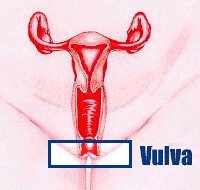
Women’s Cancer Communication Project
Coordinated by the European Institute of Women’s Health
 |
The vulva is the name for all the female external organs, including the labia, the clitoris and the vaginal opening. It is the outer part of a woman’s vagina and looks much like a pair of lips. Cancer of the vulva is a rare type of cancer in women. Most women affected are over the age 50, though it is becoming more common in women under the age of 40. |
Vulvar cancer can sometimes be associated with cervical cancer. Like most cancers, cancer of the vulva is best treated if it is found early. Vulvar cancer is not on the increase.
SIGNS AND SYMPTOMS
- If you experience any bleeding or discharge that is not related to your periods.
- The skin of the vulva looks white and feels rough, and stays like this, despite normal hygiene.
SIGNS AND TESTS
If you have any of the above symptoms, your doctor will carry out certain tests to check for the presence of this cancer. Your doctor will usually begin by looking at the vulva and feeling for any lumps. Your doctor may then perform a biopsy. You may feel some pressure but you usually won’t feel any pain. Cancer in the vulva may spread to the vagina, the anus, the urethra (the tube through which urine passes) and the nearby lymph nodes. Therefore early detection is vital.
TREATMENT
Three kinds of treatment are used to treat cancer of the vulva: Surgery – the operation for cancer of the vulva is called a vulvectomy and it involves removing all the affected area, probably including the clitoris.
Radiotherapy and Chemotherapy
The extent of the cancer will determine which form of treatment you will receive. SO, REPORT SORES OR SMALL GROWTHS IN THE VULVA AREA TO YOUR DOCTOR.
![]()
Cancom Index | Previous | Next
